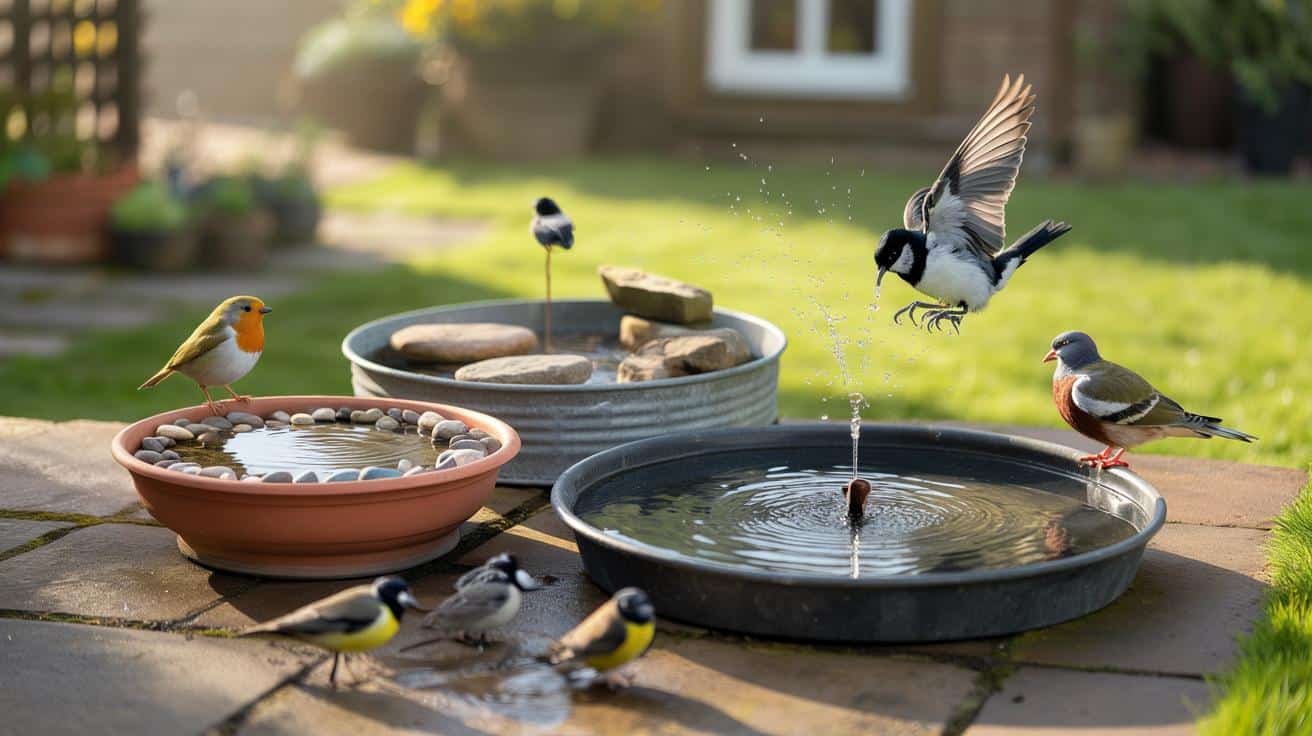A near-free fix can change everything fast.
Many gardens fall quiet not because food is scarce, but because clean, accessible water is. Switch focus to water and visits often jump within days. It costs little, takes minutes to set up, and avoids the mess and pests that can follow scattered seed.
Why water lures more birds than seed
Birds drink many times a day. They also bathe to keep feathers clean, which helps them fly, stay warm and shed parasites. A reliable, shallow source of water answers both needs. When you offer it, word spreads along hedges and fence lines, and regulars bring more visitors.
In dry spells, lawns harden and puddles vanish. Even in wet weather, clean water that’s easy to reach is rare. A simple saucer filled to a gentle depth gives robins, blackbirds, tits and finches a safe stop. Add a second and third source and activity often snowballs, because birds avoid queuing and prefer to bathe away from drinking spots.
Offer three shallow water sources, refreshed daily. Many gardens report a sharp rise in visits within a week.
What to put out today
You do not need a fancy bird bath. Start with what you have at home and keep it shallow and stable.
- Plant saucers (terracotta or plastic), 25–35 cm wide, filled 2–5 cm deep.
- A mixing bowl or roasting tin, with stones to form steps and perches.
- An upturned bin lid with a slight lip, levelled and part-filled.
- A shallow tray on a sturdy crate, plus a stick or brick as an escape ramp.
- A slow-drip bottle or a tiny solar fountain to keep water moving and clean.
Seed versus water: the simple trade-off
| Option | Upfront cost | Weekly running cost | Rodent risk | Care routine | Key benefit |
|---|---|---|---|---|---|
| Seed feeders | £10–£25 feeder + £5–£15 seed | £3–£8 (refills) | Higher from spillage | Sweep spillage; clean feeders weekly | Calories in winter or cold snaps |
| Water sources | £0–£10 (saucers/repurposed dishes) | £0–£0.20 (tap water, cleaning) | Low if kept tidy | Change daily; scrub weekly | Hydration and bathing year-round |
Placement and hygiene that keep birds safe
Set water where birds feel secure, and where you can clean and refill without a fuss. Small details make a big difference to both safety and turnout.
- Depth: 2–5 cm for most garden birds; add pebbles so smaller birds can stand.
- Visibility: place 2–4 metres from dense cover, so birds can dash to safety, but cats cannot ambush.
- Surface: rough saucers beat slick metal; add a brick as a landing platform.
- Cleanliness: change water daily in warm weather. Scrub weekly using a 1:9 bleach-to-water solution, then rinse and dry.
- Consistency: keep water available at the same spots. Routine builds trust and repeat visits.
Keep water shallow, clean and visible. Place it 2–4 metres from cover and add stones for safe footing.
Winter and heatwave tweaks
In frost, do not add salt or glycerine. Pour in warm (not hot) water to melt ice, or float a ping-pong ball to keep a small gap open during breezes. A cheap solar bubbler can also slow freezing. In heat, top up twice a day, and offer one dish in light shade to reduce evaporation and algae.
If you spot sick or unusually lethargic birds, pause communal water for several days, clean thoroughly, and follow local guidance. Report multiple dead wild birds to the relevant authority. Good hygiene protects both birds and people.
Who turns up, and when
Mornings often bring the busiest traffic. Blackbirds arrive early to bathe. Robins and dunnocks sip and leave. Blue tits and great tits drop in through the day, especially if you add a gentle dripper. Starlings sometimes arrive in loud groups for a splash. Woodpigeons prefer a sturdier tray with room to perch. Late afternoons can match mornings when temperatures rise.
On a modest patio, many households see five to twelve species within a fortnight of adding water. Numbers vary by season and nearby habitat, but regular fresh water lifts the baseline almost everywhere, rural or urban.
Avoid these common mistakes
- Water too deep: small birds struggle and avoid it. Keep it shallow and graduated.
- Bowl on the ground with no escape ramp: add a stick or brick that reaches the rim.
- Dirty dishes: algae and droppings spread disease. Change daily, scrub weekly.
- Right against a fence or hedge: cats can pounce. Leave a clear buffer of a few metres.
- Slippery metal bowls in full sun: too hot in summer, icy in winter. Use textured containers.
- One overcrowded bath: provide two or three small dishes to cut conflict and queues.
No seed? No problem. Clean water, shallow depth and consistency draw birds back day after day.
If you still want to feed
Food has its place, especially in mid-winter or cold snaps. Offer small amounts, little and often, and clear spillage to deter rats and mice. Choose quality mixes or sunflower hearts. Use baffles or trays to catch waste, and store bags in sealed metal bins. Pair any feeding with water; the combination supports birds safely without turning the patio into a mess.
Extra gains you can make this weekend
Build a mini bath for under £5
Pick up a 30 cm terracotta saucer (£3–£5), add a handful of gravel and a fist-sized stone, and set it on two bricks for stability. Fill to 3 cm, test with a finger for a gentle slope, and you are done. Total time: ten minutes.
Turn the lawn into a buffet without feed
Water a patch of soil in the evening for ten minutes during dry spells. Blackbirds and thrushes probe the softened ground for worms and beetles at dawn. This approach adds natural protein without extra cost or clutter.
One final nudge: keep a small notebook or a phone list of species you spot each week. A simple record helps you see patterns, adjust water depth or placement, and measure the payoff from such a small change. Most households spend nothing, save on seed, and gain a daily front-row show of feathers and song.








Brilliant tip—switching from seed to water tomorrow. Curious if three bowls really cut the queing like you say, or do the bossy blackbirds still hog the bath?
30% by tomorrow sounds like a marketer’s stat. Any data beyond anecdotes or a link to a study? Also, about the 1:9 bleach clean: how long should we rinse to avoid residue—do you reccomend a final sun-dry?